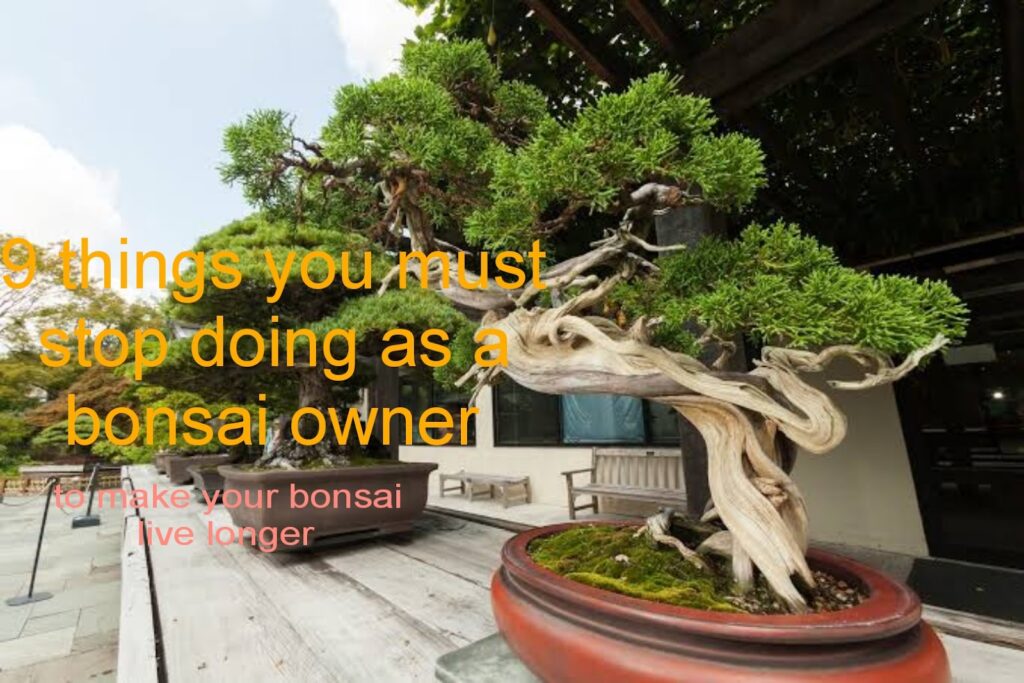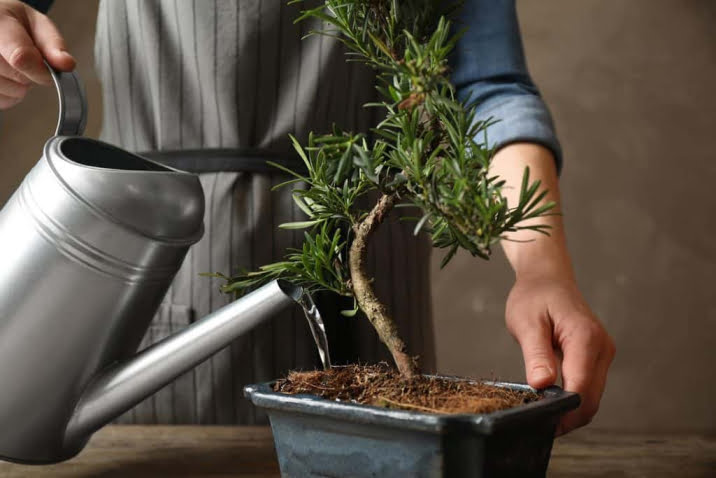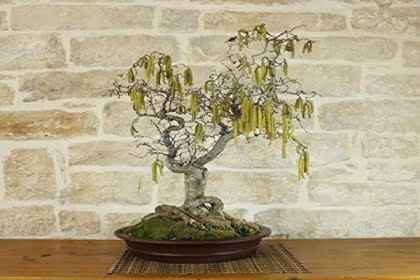
Are you not getting the expected results from your bonsai? or is your tree dying? we have noticed these are the most common issues bonsai owners face, especially the beginners. And if you have landed on this page, I can assume that you are facing something similar as well.
I hate to break it to you but your tree is dying or wilting because of you. In fact, 75% of new bonsai owners face failure in their 1st month of owning one.
But all hope is not lost, knowing the prominent bonsai mistakes and their fixes will not only bring your dying tree back to life but also will help you to not repeat the same mistakes ever again.
1. Underwatering:

Growing a bonsai tree in your house is like taking a piece of nature and keeping it alive in a small pot. When they are living in the wild, they extend their roots and absorb water and nutrients from the soil by themselves. So you can understand how crucial it is to water them when they are living in a pot.
If you forget to water it, the soil will become bone dry first and then the roots will dry out. If kept like that for longer, the bonsai will fail.
Signs:
Dry leaves
Withering leaves
Yellow foliage
Dry soil.
Solution:
If you detect it early, there’s a chance to save your Bonsai. Give it a fine watering and follow a care routine. But if the roots have dried up completely, it might be too late to save your tree.
The amount of water your Bonsai needs depends on its type and the soil it’s in. Some Bonsai, especially cheap starter ones, come with clay-like soil that doesn’t absorb water well. To help your tree recover, water it thoroughly, wait a bit, and then water it again to ensure the soil soaks up all the moisture. Once it’s healthier, you can repot it with the right soil mix as suggested in our care guide.
However, here’s a list of common bonsai species and their watering guide:
| Bonsai species | Watering frequency |
| Juniper | Moderate |
| Ficus | Frequent |
| Pine | Moderate |
| Maple | Frequent |
| elm | Moderate |
| jade | Infrequent |
| serissa | Frequent |
2. Overwatering:
Excessive amount of anything backfires. The same goes for watering a bonsai- you need to water them to keep them alive but an excessive amount of watering will kill them instead of keeping them alive.
Yes, you can definitely overwater a bonsai even after potting them in a well-draining soil cause, Watering your bonsai and letting the soil dry out a bit in cycles encourages root growth and keeps your plant healthy.
The constant waterlogging situation will invite harmful bacteria and microorganisms around the root. They will turn the roots mushy and it will eventually die. It goes without saying, that your bonsai’s longevity depends on the way you water it.

An overwatered bonsai tree
What leads to overwatering a bonsai?
It’s a good thing pretty much all the reasons are the results of your bad habits and they all are in your control.
These are;
1. The soil mix you are using for your bonsai. For example, garden soil. These soils actually get compacted over time. They leave little to no air for the roots and make the soil hard to dry out.
2. Your love language for your bonsai is watering them at every given chance. You are probably keeping a watering routine for your tree. But I hate to say that this routine might be killing your tree gradually. Trees’ water needs vary, so avoid a fixed schedule; instead, use your observation and then decide.
3. If you are placing your tree in a bigger pot in the hope of getting a bigger tree, there’s a chance that it will backfire because it will take ages to fill the pot with its roots. Your tree will be sitting in mushy and wet soil for a longer period of time. If you desire to grow your bonsai bigger, place them in the ground and then gradually transfer them to the pot.
Signs of over-watered bonsai:
Yellowing/browning of the leaves
Wilting leaves
Leaves falling off
The tree becomes wobbly (be gentle when checking).
Wild weeds that thrive in soggy climates will grow in the pot.
How to revive an overwatered bonsai?
- Isolate the tree and put it near a window or outside where air is circulating well.
- Leave the foliage while watering.
- Water when the top half of the soil is dry.
- Don’t give any kind of stress by fertilizing or re-potting, wait till it fully recovers.
For a detailed description check out the article:- How to revive an overwatered bonsai tree?
3. Not fertilizing enough:
Issues with fertilization don’t kill the plant, but to make it live longer right fertilization is important. As they reside in small pots malnutrition will slow the growth, which is definitely not the sign of a long-lasting bonsai.
One of the specific causes of bonsai trees’ under-fertilization, which is not normally seen or taken into consideration is frequent watering. Even if you apply sufficient fertilizer, any nutrients that are not directly soaked in the soil can be flushed away with watering, leading to nutrient depletion.
The main reasons for under-fertilization are;
- Frequent watering
- Not enough fertilizer
- The wrong type of fertilizer
How to determine under-fertilized bonsai:
1. Yellow leaves: In under-fertilization, older leaves turn yellow first then the younger ones.
2. Stunted growth: If your trees are developing too slowly or appear diminutive, it could be a sign of nutrient insufficiencies.
3. Discolored leaves: Not only yellow, but the leaves can also turn pale as well, specifically in between the veins, which is prominently caused by iron deficiency or what we normally call chlorosis.
4. Weak branches: Fertilizer delivers vital nutrients that boost the tree’s structure and improve its resilience to harsh weather events. Branches that are prone to breakage are caused by less amount of fertilizer in the soil.
To revive an under-fertilized tree you need to fertilize it more (obviously). But increase the amount gradually in order to not put them in shock. Also make sure your fertilizer contains basic nutrients like nitrogen, phosphorus, and potassium, as well as micronutrients that are crucial for your bonsai growth.
| Under-fertilization in Bonsai | Causes | Symptoms | Remedies |
| Lack of Essential Nutrients | – Frequent watering – Inadequate fertilizer – Incorrect fertilizer type | 1. Yellowing leaves (starting with older leaves) 2. Stunted growth 3. Pale leaves between veins (chlorosis) 4. Weak branches | Gradually increase fertilizer. Ensure a balanced mix of essential nutrients (nitrogen, phosphorus, potassium) and micronutrients |
| Nutrient Loss through Watering | Frequent watering can flush away nutrient | Nutrient deficiency, slow growth | Adjust watering frequency, use slower-release fertilizers, and observe for signs of nutrient loss. |
| Soil Nutrient Depletion | Lack of nutrient replenishment due to a small pot size | Gradual decline in tree health, slow growth | Repot or refresh the soil to provide new nutrients. |
| Inadequate Fertilization Knowledge | Not using fertilizer properly | Lack of growth, overall poor health | Learn proper fertilization techniques and schedules. |
Buy the best bonsai fertilizer for sale.
4. Keeping them in the dark:
Bonsai need light in order to survive. Sunlight lets plants conduct photosynthesis, a method that is needed for plants’ development and health. Photosynthesis allows plants to synthesize glucose from carbon dioxide and water and discharge oxygen.
It’s true there are indoor bonsai species that require little to no sunlight, but keeping them in the dark constantly will not give them healthy growth or ensure their longevity.
Some plants manage to grow in artificial lights, but they will not thrive. Most indoor bonsais are sub-tropical trees. So, they will appreciate lots of sunlight, artificial grow lights alone won’t be enough, you need to combine them with natural light as well. I will recommend you to Place them near a south-facing windowsill during daytime.
Tips:
1. If you experiment with different light levels, keep a keen eye to see how they are responding to each of your actions.
2. When you are placing the tree near your window, make sure to rotate it from time to time. Trees naturally try to reach the source of light, so if one side gets more light than the other, you will have a tree with imbalanced growth.
5. No fresh air:
Bonsai are like people or animals, need air for photosynthesis (food production) and to breathe, using oxygen to convert food into energy. This connection between air and indoor bonsai is crucial for their well-being.
Effect of less air circulation above the ground:
- Less indoor air can restrain the bonsai of essential oxygen and introduce toxic gases.
- When indoors, fresh air depletes, leading to toxic gas expansion, similar to a packed and sealed banana in a plastic bag.
- This lack of refreshed air can harm the foliage of the bonsai, causing harm or even death.
- Dust and debris can restrict gas exchange and light absorption on tree leaves.
Effect of less air circulation below the ground:
- Air is essential for root health as well. It allows bonsai to breathe; lack of air leads to root failure.
- Root loss often goes overlooked but is a significant reason for indoor bonsai stress.
- Damaged roots can’t absorb water and nutrients, resulting in discolored leaves and reduced bonsai’s lifespan.
- Over-watering is the primary culprit, in reducing the amount of air in the soil.
6. Misting the leaves:
I have recommended misting bonsais to many people and I still do, cause it has numerous benefits like boosting humidity levels and keeping it dust-free, but there should be some warnings.
Misting should never cause any harm to your bonsai unless you go overboard with it.
When the leaves get overloaded with water, they will gradually form molds on their surface. Along with that, if the bonsai is staying in a lower air circulation area, its life will be at stake.
When you shouldn’t mist your bonsai?
- Some plants don’t like to be misted, especially the ones with the fuzzy surface of their leaves. Cause they tend to get wet and heavy for longer periods of time, which leads to rotting.
| Bonsai that appreciates mist | Bonsai that doesn’t appreciate mist |
| Ficus | Pine |
| Juniper | Crassula |
| Japanese maple | Fockea |
| Elm | Azalea bonsai |
- Some plants that like mist might not appreciate it if they are affected by pests or fungi. The pests and fungi that are drawn towards a moist environment will get the ideal atmosphere for reproduction and will damage the tree in the process.
Tips while misting:
- Before using the spray bottle on a plant I will always advise you to test it on your hands first, observe the pressure, and then proceed.
- Hold the bottle a little bit far while spraying, this will ensure that the leaves are getting misted instead of getting wet.
7. Repotting in a poor season:
Re-potting is like performing surgery on your tree. You have to be careful.
So, I will advise you to avoid re-potting from November to February, cause they aren’t actively growing at this stage and if they get any kind of shock it will be too much for them to handle and will stun their growth.
The best time to re-pot is the beginning of the march when they will resume their activities and will recover from the shock easily.
Bonsai don’t actually need re-potting every other year unless the roots of the tree totally invaded the soil and need more space for healthy growth.
8. Not checking the soil and leaves regularly:
All the points I have mentioned in this article can only be cured if you scrutinize your bonsai from time to time. Checking your bonsai will tell you if they need water if the soil is bad, if the temperature is low, or if it’s getting infested by some intruders.
I still remember my first Jade plant. I took the statement “low maintenance” way too seriously and left it unattended for months (only water it from time to time). The leaves from the bottom of the tree were yellow and it had mold all over it. Fortunately, it got saved before it was too late, just by placing the tree outside for weeks.
How to check your bonsai properly:
- Check the leaves for discoloration, droopiness, and curls.
- Check the root’s color. Healthy roots of most bonsai species should be white.
- Take a magnifying glass and check for any pests or molds all over the tree.
- You can take a picture of your tree every week and compare its growth and overall health.
9. Ignoring pests and disease:
Pests are a common problem in bonsai trees, but they often go unnoticed because they are tiny. When you don’t check your tree you won’t even know those intruders having a feast in your tree, until it’s too late. It can spread to nearby trees as well. So, as I mentioned in the previous point checking your tree is the only way to save them.
Here are some of the common pests and their treatment:
| Pest | Identification | Treatment |
| Aphids | Tiny, pearl-shaped, Sapsucking bodies. | Spray with Water. Insecticidal Soaps and Horticultural Oil. |
| Mealybugs | Small, oval-shaped bugs, that hide under the cool parts of the bonsai. | Mix rubbing alcohol with water and apply on the infected places. |
| Spider mites | Small, red-colored spider, that lives underside of the leaves. | Treat With Rubbing Alcohol. Spray With Horticultural Oil. Apply Insecticidal Soap. Apply Neem Oil. |
| Scale | Oval-shaped, brown-colored insects, look like bumps on the bark of the tree. | Treat With Rubbing Alcohol. Spray With Horticultural Oil. Apply Insecticidal Soap. Apply Neem Oil. |
| Caterpillars | plump and green, with a dark, white-edged ‘saddle’ | Spray neem oil. |
Pests aren’t the only issue your bonsai will face, you need to be ready for disease as well. Diseases are often harder to treat. Here are some of the common diseases your bonsai can face and how to treat them.
| Disease | Cause | Symptoms | Treatment |
| Blight | high humidity, excessive moisture, and poor air circulation | Discoloration, Wilting, Defoliation, Stunted growth | Pruning the affected parts and applying fungicides like Liquid copper fungicide. |
| Sooty mold | High humidity | Black coating, Reduced photosynthesis, sticky residue. | Remove the residue with a soft wet cloth and improve air circulation. |
| Rust | Moist condition, infected plant material. | Rust-colored spots, leaf drop. | Remove heavily infected parts and use fungicide. |
| Black spot | High level of moisture around the tree. | circular black or brown spots on the leaves | Apply fungicide. |
Cheat sheet for keeping your bonsai happy and healthy:
Don’t:
- Don’t re-pot just after getting your bonsai.
- Do not overwater your bonsai.
- If the tree is suffering, refrain from Fertilizing your tree till you figure out why it is suffering.
- Do not attempt heavy pruning on your tree in winter.
- Don’t try to revive a weak tree back to health by re-potting and fertilizing it.
- Do not leave the tree unattended for weeks.
DO:
- Give your bonsai time to familiarize itself with its new home.
- Check the plant info and monitor the soil and water it based on it.
- Fertilize your tree during the growing season but avoid over-fertilizing it.
Growing a bonsai tree is a fascinating long-term hobby. It might seem hard at the beginning, but once you understand your bonsai’s nature it will be easy. Try to avoid the things I have mentioned and use your own observations to keep a happy and healthy bonsai for years to come. Remember that, checking your bonsai and keeping patience is a must in this bonsai journey. Keep learning and improving!
